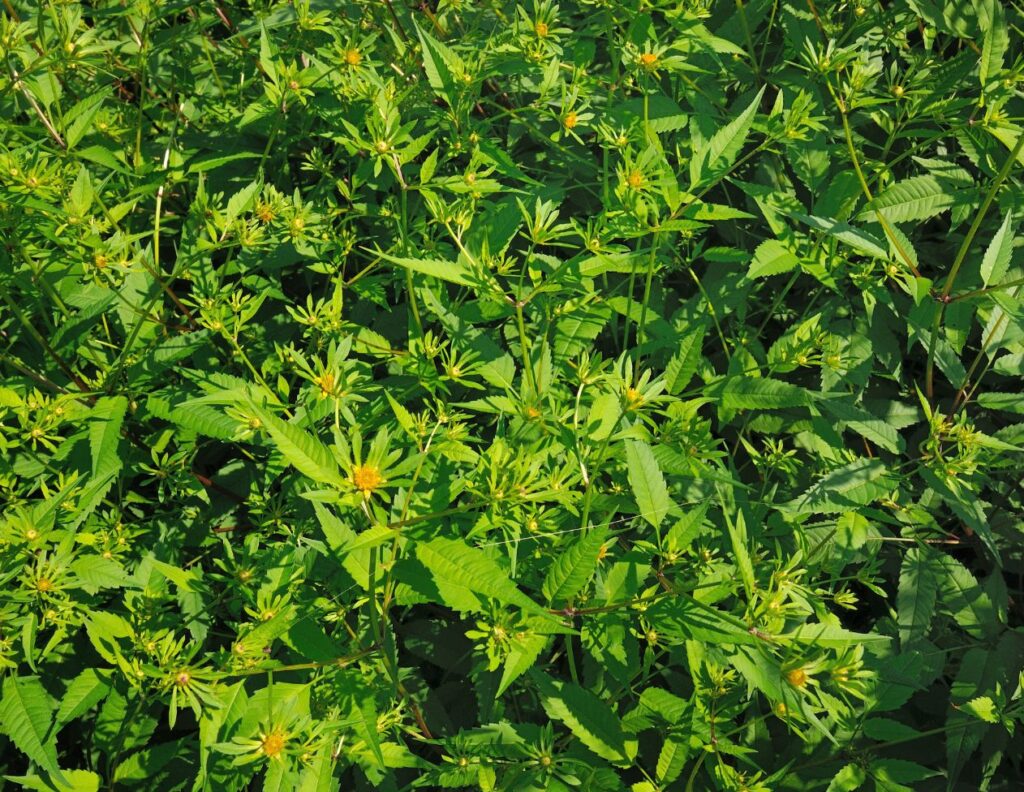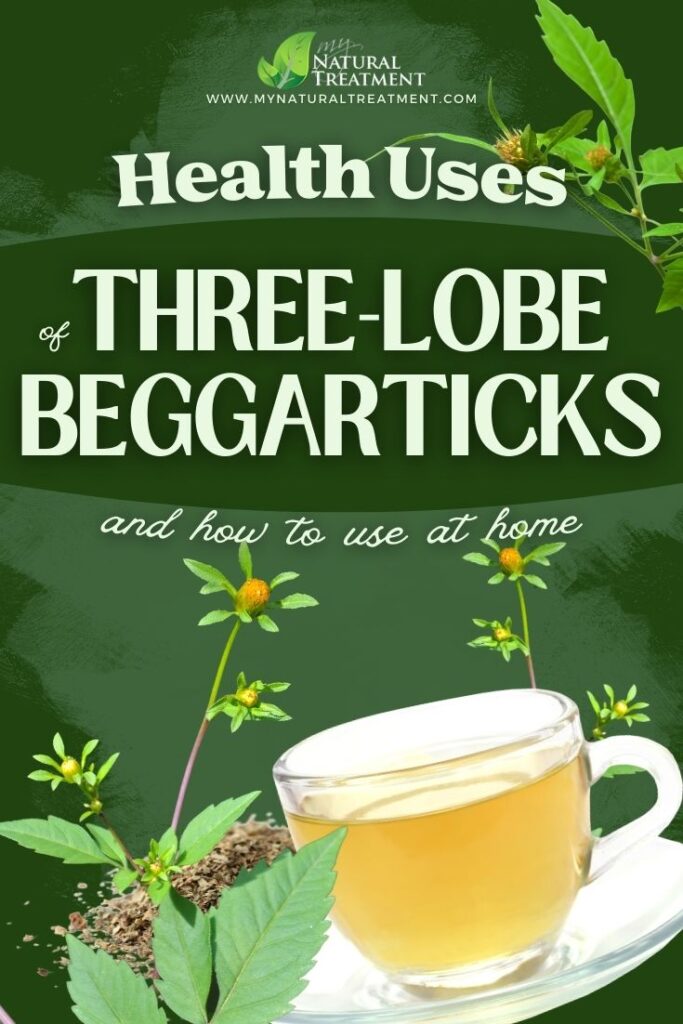Want to learn about the most important three-lobe beggarticks uses with exact recipes and remedies? Continue reading and find out.
Three-lobe beggarticks (Bidens tripartita) is one of the most praised medicinal plants due to its multiple beneficial effects. It is an excellent immunomodulatory plant, it has anti-inflammatory and bactericidal action and is most often used in the form of infusion alone, or in combination with other plants. Is most commonly used in conditions related to arterial circulation and heart contraction, but it also has known sedative, diuretic, diaphoretic, and laxative properties. Before we show you the main three-lobe beggarticks uses, let’s see how to harvest this magnificent medicinal plant.

In This Article You Will Find:
How to Harvest Three-Lobe Beggarticks
The three-lobe beggarticks plant usually grows in wet areas such as the edge of ponds, rivers, and lakes but also in corn fields (do not harvest from chemically grown crops). It blooms from June to September. For medicinal uses, you can harvest the leaves, flowers, and fruits of this plant. A simple three-lobe beggarticks tea made by steeping a teaspoonful of finely chopped herb in 200 ml of hot water. After a few years of drinking this tea instead of coffee in the morning, you can build up your immune system and no longer be sensitive to allergens.
10 Three-Lobe Beggarticks Uses with Remedies
1. Tonsilitis
Steep one tsp of three-lobe beggarticks and another one of sage in one cup of boiling water for one hour. Strain and add 2 tablespoons of Aloe Vera gel or juice and 3 tablespoons of lemon juice. Drink 1/4 cups of warm tea twice a day, after eating. Before drinking the tea, have a tsp of raw honey, that you hold in your mouth until it completely melts down. Swallow down with the tea.
2. Angina with Hypertension, Atherosclerosis, Neurosis, Rheumatic Pains
Combine together 10 g of three-lobe beggarticks, 10 g of calendula flowers, 10 g of licorice root, 5 g of valerian root, and 5 g of dill seeds. Steep one tablespoon of this herbal mix in one cup of hot water for one hour, covered. Strain the tea, split into 3 portions, and drink each one in between meals.

3. Tongue Cancer
Put one heaped tsp each of three-lobe beggarticks and cleavers (Galium aparine) and 10 cloves in 2 cups of cold water, bring to a boil, turn the fire off, and steep for 30 minutes. Rinse your mouth 5-6 times a day with the warm tea. If possible, after each rinse chew on a tiny piece of lovage root.
4. Fibrocystic Breasts
Combine the following finely chopped medicinal herbs:
- 2 tablespoons of calendula
- 2 spoons of ground-ivy (Glechoma hederacea)
- 2 tablespoons of stinging nettle
- 2 tablespoons of celandine
- 2 tablespoons of cotton thistle (Onopordum acanthium)
- 5 tablespoons of red clover flowers
- 5 tablespoons of burdock root
- 3 tablespoons of peony root
- 4 tablespoons of three-lobe beggarticks
- 4 tablespoons of mash cinquefoil (Potentilla palustris syn. Comarum palustre)
Boil a spoonful of the herbal mixture in a thermos with 350 ml of water and steep for 4-6 hours. Strain the tea and drink warm, 120 ml at once, 3 times a day, one hour before meals. Continue for 30 days, pause for 10 days, and resume the same way until you see results.

5. Whooping Cough
You can turn whooping cough into a productive cough, by using the following plants:
- three-lobe beggarticks
- white horehound (Marrubium vulgare)
- eyebright (Euphrasia rostkoviana)
- mulberry leaves (Morus alba)
- two-leaf squill (Scilla bifolia)
- oak bark
- ivy-leaved speedwell (Veronica hederifolia)
- dense flower mullein flowers (Verbascum densiflorum)
- shepherd’s purse (Capsella bursa-pastoris)
- lungwort (Pulmonaria officinalis)
- marshmallow (Althaea officinalis)
- agrimony (Agrimonia eupatoria)
- marjoram
- cowslip (Primula veris)
- sage
- common daisy (Bellis perennis)
First, put the oak bark in the cold water and bring it to a boil. Separately steep the rest of the dry plants in boiling water, then strain. Combine the two infusions. For a cup of tea tea use only 2-3 plants from the above list, then change them to see which of the herbs/herbal combination is the most effective.
6. Blood Detox
The recipe has a strong blood detoxification effect, which is why it is prescribed to people with allergic rashes, urticaria, eczema, and furunculosis. Combine one spoonful each of dead nettle flowers, horsetail, three-lobe beggarticks, and one teaspoon of birch buds or leaves, and put in 650 ml of water. Bring the plants to a boil, and simmer on low heat for another 15 minutes. Steep the decoction for an hour in a thermos, and drink warm in three installments (200 ml each), 3 times a day, after meals.
7. Food Poisoning
Combine together the following herbs and seeds: 3 tablespoons of flax seeds, 3 tablespoons of common cough herb, 2 tablespoons of birch buds, and 2 tablespoons of three-lobe beggarticks. Steep 3 tablespoons of the blend in a liter (4 cups) of boiling water until the infusion cools down. Drink 50 ml of this tea every 30 minutes until food poisoning symptoms subside.
8. Skin Problems
For the treatment of skin conditions, namely psoriasis, furunculosis, eczema, bedsores, thermal, chemical, and radiation burns, combine 2 tablespoons each of smoke tree leaves (Cotinus coggygria), sage, and hops, and 4 tablespoons each of the elecampane roots, common couch herb, hawthorn berries, and three-lobe beggarticks.
Boil three tablespoons of the blend in 500 ml (2 cups) of water for 10 minutes on low heat. Then steep the tea for 4 hours in a thermos or in a well-covered pot. Drink 50 ml of this decoction, 3 times a day, 2 hours after meals. Or, apply topically to the affected areas, 2 times a day, using a cotton pad soaked in the warm decoction. You can also add this concentrated tea to your bathwater when bathing (this is especially good for psoriasis).
9. Dermatoses
Combine equal parts of three-lobe beggarticks, dandelion root, calendula flowers, spiny cocklebur (Xanthium spinosum), and tormentil (Potentilla erecta). Steep one tablespoon of this herbal blend in one cup of hot water in a thermos mug for 8 hours, or overnight. Strain and drink in three reps, 30 minutes before meals. Drink two cups of this tea a day.
10. Lymphostasis
Three-lobe beggarticks, in combination with other powerful herbs, can improve lymphostasis when used for local baths. Prepare a decoction by boiling 6 tablespoons of three-lobe beggarticks, a medium-sized, chopped creeping thistle (Cirsium arvense) in 3 liters of hot water for 5 minutes. Strain the decoction after the tea has chilled and bathe your feet in this preparation for 15-20 minutes, 2 times a day.
Three-Lobe Beggarticks Side-Effects
Immunomodulatory plants, including three-lobe beggarticks, are not recommended for long-term use, as the body can gradually get used to it, and thus the herb can diminish its effectiveness. Three-lobe beggarticks should not be used during pregnancy, during breastfeeding, by children under 12 years of age, or in case of individual intolerance to the plant.
Read Also: 9 Health Uses of Nasturtium & How To Cook It
Indeed, three-lobe beggarticks is a miraculous healing plant, especially when combined with other medicinal plants. If you’ve enjoyed learning about the most notable three-lobe beggarticks uses and the remedies presented here, please share this article so more people can use this information. Stay healthy, naturally!
Share on Pinterest ❤️

